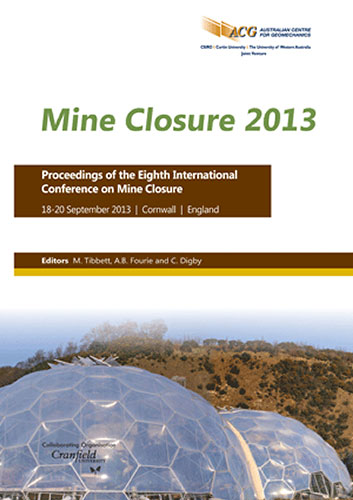Treating mine waters in the Lorraine coal field – feedback from the La Houve treatment plant

|
Authors: Koeberlé, N; Levicki, R; Kaiser, J; Heitz, S Paper is not available for download Contact Us |
DOI https://doi.org/10.36487/ACG_rep/1352_15_Koeberle
Cite As:
Koeberlé, N, Levicki, R, Kaiser, J & Heitz, S 2013, 'Treating mine waters in the Lorraine coal field – feedback from the La Houve treatment plant', in M Tibbett, AB Fourie & C Digby (eds), Mine Closure 2013: Proceedings of the Eighth International Seminar on Mine Closure, Australian Centre for Geomechanics, Cornwall, pp. 171-181, https://doi.org/10.36487/ACG_rep/1352_15_Koeberle
Abstract:
Coal extraction in the Lorraine coal field ended in 2004, after 150 years of mining. The end of mine drainage pumping caused the flooding of 180 million m3 of mine cavities. After around two to five years of filling, pumping became necessary to keep pace with rising levels of iron-containing water. The elevated levels of iron mineralisation in the mine water are such that the water cannot be discharged directly into the natural environment, making treatment a necessity. In the Lorraine coal field, the complete treatment system will comprise three treatment plants with a maximum cumulative flow rate estimated at 1,000 m3/h. The plants are of the passive type, with the mine water flowing over aeration cascades into settling tanks and lagoons planted with reeds before being discharged into the natural environment. Two plants are currently operating, one since 2009 and the other since 2012. The La Houve plant, in operation since 2009, has provided experience over three years, and this feedback enables a comparison with initial predictions. The first results show that the model for decrease in the iron concentration of the mine water used initially does not fit with the La Houve case. We have formulated a hypothesis allowing adjustment of the model to observations; other phenomena remain to be studied to explain the behaviour of the mine reservoir. Where treatment plant efficiency is concerned, 98% of iron is removed on average and there is a seasonal pattern.
References:
ANTEA (2004) Secteur Ouest, U.E. La Houve (57), Etats Transitoire et Final des Eaux Souterraines et Superficielles après Arrêt des Exhaures, Etude Hydrogéologique et Hydrologique, Rapport A 33301/A.
Blachere, A. and Lefort, D. (2003a) Etude Prévisionnelle de la Qualité des Eaux après Remplissage des Mines des Secteurs Est, Ouest et Centre, Bureau d’études Cesame.
Blachere, A. and Lefort, D. (2003b) Prévision de la Qualité des Eaux de la Mine de La Houve – Proposition d’un dispositif de traitement passif, CESAME, Fraisses.
Kaiser, J. and de Vicentin, S. (2013) Bassin houiller lorrain, Gestion de la station de pompage et station de traitement des eaux de résurgence minière – Commune de Creutzwald (57150), secteur Ouest. Rapport Annuel 2012, BRGM/RP-61812-FR, 74 p.
PIRAMID Consortium (2003) Engineering Guidelines for the Passive Remediation of Acidic and/or Metalliferous Mine Drainage and Similar Wastewaters, European Commission 5th Framework RTD Project No. EVK1-CT-1999-000021, Passive In-situ Remediation of Acidic Mine / Industrial Drainage (PIRAMID), University of Newcastle upon Tyne, UK, 166 p.
© Copyright 2025, Australian Centre for Geomechanics (ACG), The University of Western Australia. All rights reserved.
View copyright/legal information
Please direct any queries or error reports to repository-acg@uwa.edu.au
View copyright/legal information
Please direct any queries or error reports to repository-acg@uwa.edu.au